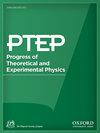利用最大共形原理研究重夸克极点质量和运行质量之间的关系
IF 8.3
4区 物理与天体物理
Q1 Physics and Astronomy
引用次数: 0
摘要
利用最大共形原理(PMC)可以得到微扰量子色动力学(pQCD)中O(\alpha _s^4)阶重夸克质量的极点和运行质量的关系。利用 PMC,我们确定了重夸克质量比的最优重正化尺度,它独立于重正化尺度和方案,最高可达 $\alpha _s^4$阶。然后得到了重夸克的PMC极点质量的精确值:$M_b^{text{PMC}}=4.86^{+0.03}_{-0.02}$ GeV,$M_t^{text{PMC}}=172.3\pm 0.6$ GeV,以及在PMC尺度下的运行质量$overline{m}_t^{text{PMC}}=162.6\pm 0.7$ GeV。本文章由计算机程序翻译,如有差异,请以英文原文为准。
Relation between pole and running masses of heavy quarks using the principle of maximum conformality
The relation of the pole and running heavy quark masses of order O $(\alpha _s^4)$ in perturbative quantum chromodynamics (pQCD) can be obtained using the Principle of Maximum Conformality (PMC), a formalism that provides a rigorous method for eliminating renormalization scale and scheme ambiguities for observables in pQCD. Using PMC, an optimal renormalization scale for the heavy quark mass ratio is determined, independent of the renormalization scale and scheme up to order $\alpha _s^4$. Precise values are then obtained for the PMC pole masses of the heavy quarks $M_b^{\text{PMC}}=4.86^{+0.03}_{-0.02}$ GeV, $M_t^{\text{PMC}}=172.3\pm 0.6$ GeV, and the running mass $\overline{m}_t^{\text{PMC}}=162.6\pm 0.7$ GeV at the PMC scale.
求助全文
通过发布文献求助,成功后即可免费获取论文全文。
去求助
来源期刊

Progress of Theoretical and Experimental Physics
PHYSICS, MULTIDISCIPLINARY-PHYSICS, PARTICLES & FIELDS
CiteScore
12.00
自引率
5.70%
发文量
148
审稿时长
17 weeks
期刊介绍:
Progress of Theoretical and Experimental Physics (PTEP) is an international journal that publishes articles on theoretical and experimental physics. PTEP is a fully open access, online-only journal published by the Physical Society of Japan.
PTEP is the successor to Progress of Theoretical Physics (PTP), which terminated in December 2012 and merged into PTEP in January 2013.
PTP was founded in 1946 by Hideki Yukawa, the first Japanese Nobel Laureate. PTEP, the successor journal to PTP, has a broader scope than that of PTP covering both theoretical and experimental physics.
PTEP mainly covers areas including particles and fields, nuclear physics, astrophysics and cosmology, beam physics and instrumentation, and general and mathematical physics.
 求助内容:
求助内容: 应助结果提醒方式:
应助结果提醒方式:


